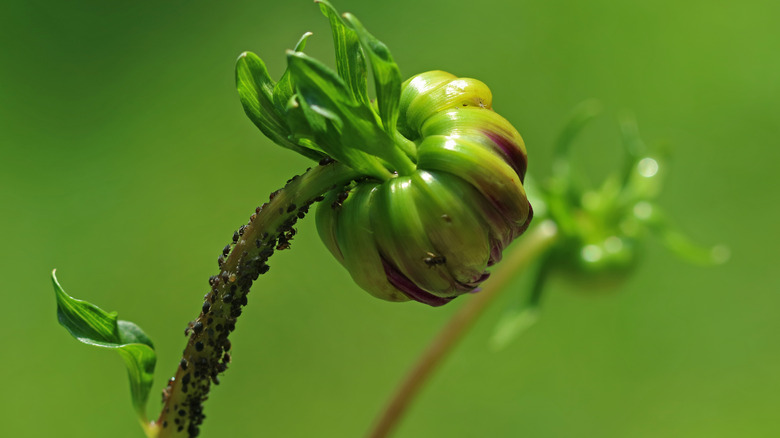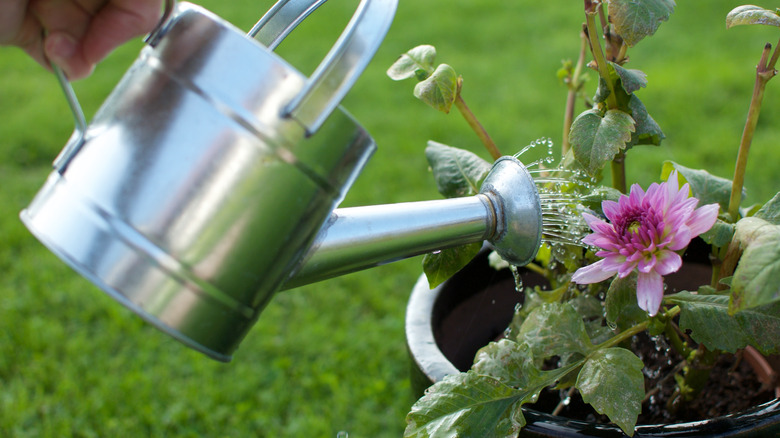Welcome to the charmingly intricate world of dahlias, the garden’s masterpieces loved by a legion of nature’s finest pollinators. These plants are floral royalty, drawing admiration with their magnificent, kaleidoscopic displays. However, the royal status also transforms them into prime targets for invaders that can ravage their aesthetics and health. So, what pests eat dahlias? Well, the list of culprits can be long and quite distressing for every dahlia parent: Think aphids, slugs, thrips, spider mites, leafhoppers, caterpillars, and earwigs. And while some, like spider mites, might be invisible to the naked eye, their disastrous handiwork on your plants is hard to miss.
The damage signature may vary across pests, though: leafhoppers leave distinct green or brown stipples speckled across leaves, while aphids grotesquely distort leaf shapes and host mold growth, turning the once-pristine landscape of your dahlia leaves into a distorted reality. And so you might wonder, “How do I protect my dahlias from bugs?” Contrary to the power these pests might possess, they aren’t invincible. However, steering clear of chemical pesticides is the unanimous vote amongst eco-conscious gardeners, considering these substances’ potential to harm your garden’s pollinators (butterflies and bees), disrupting the helpful ecosystem nurturing your dahlias. Thus, understanding the pests, their impact, and the sensible methods of control equips you to guard your beloved dahlias without compromising the environment’s integrity.
What pests eat dahlias?

Kicking off our showdown of dahlia pests are the earwigs. These unwelcome guests skulk among the leaf clusters during the day but turn into gruesome destroyers under the cover of darkness. Earwigs on dahlias take joy in shredding magnificent blooms and munching the healthy leaves, leaving behind a sorry sight of nibbled edges and holed foliage. A riveting encounter with their black frass in the daytime brings foreboding whispers of their terrible nocturnal banquets. Next, we have thrips. These deceitful insects fancy heat-stressed dahlias, their tiny bodies evading even the most watchful eye. So, what does thrip damage look like on dahlias? Their onslaught strips your flowers’ aesthetic glory, distorting and discoloring leaves and buds. Still, they secretively spread harmful pathogens between plants.
Barely visible, the spider mites suck the life juices from your dahlias. Their damage materializes in light-colored stipples, webs, and the eventual yellowing, wilting, and falling leaves. In their diverse species, aphids invade in droves, causing leaves to yellow and curl, weakening the plants while paving the way for honeydew sooty mold. Slugs and snails, especially fond of sprouts, can annihilate the entire tuber of a dahlia sprout and often leave behind tell-tale signs of nibbled leaves and stems. Leafhoppers swoop in with the summer sun, attacking from the underside of leaves and causing leaf discoloration, slowed flowering, and stunted growth. The finale comes with an act from cutworms, whose nocturnal feeding frenzies typically manifest in snapped shoots and ragged leaves.
How do you get rid of pests on dahlias?

Let’s begin with how to stop earwigs from eating dahlias. The real victory here involves outsmarting these pesky invaders. Keep your garden rid of organic leftovers that offer these pests cozy hiding spots. Or you could collect them with tweezers, then plunge them into soapy water. Gargoil Insect, Mite, and Disease Control, available on ARBICO Organics and Monterey Sluggo Plus from The Home Depot, are trusted champions in the fight against these crusty critters. As for the heat-loving invaders (thrips and spider mites), try routine irrigation. A weekly spray of insecticidal soap or horticultural oil can also turn the tide in your favor.
For the audacious aphids, launch strategic attacks with powerful jets of cold water, careful not to harm the dahlia leaves. You can also outsmart them with powerful deterrents like the Natural Guard Insecticidal Soap Concentrate from Walmart or even neem oil. Better yet, use soap and water to forge a homemade bug spray for dahlias. Now, onto slugs, snails, cutworms, and caterpillars. Grab these by surprise in the evening or at the break of dawn and drown them in a bucket of soapy water. For stubborn caterpillars, consider Bonide Thuricide BT Concentrate from Amazon. Alternative options for snails include garlic extract and beer traps. Finally, employ yellow sticky traps or an insecticidal soap spray to keep leafhoppers under control.



